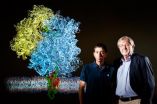(Press-News.org) CHAMPAIGN, Ill. — In two new studies, researchers provide the first detailed view of the elaborate chemical and mechanical interactions that allow the ribosome – the cell's protein-building machinery – to insert a growing protein into the cellular membrane.
The first study, in Nature Structural and Molecular Biology, gives an atom-by-atom snapshot of a pivotal stage in the insertion process: the moment just after the ribosome docks to a channel in the membrane and the newly forming protein winds its way into the membrane where it will reside.
A collaboration between computational theoretical scientists at the University of Illinois and experimental scientists at University of Munich made this work possible. Using cryo-electron microscopy to image one moment in the insertion process, the researchers in Munich were able to get a rough picture of how the many individual players – the ribosome, membrane, membrane channel and newly forming protein – come together to get the job done. Each of these structures had been analyzed individually, but no previous studies had succeeded in imaging all of their interactions at once.
"The computational methodology contributed by the Illinois group was crucial in interpreting the new cryo-EM reconstruction in terms of an atomic level structure, and testing the interpretation through simulation," said co-author Roland Beckmann at the University of Munich. "Our joint study is unique in so closely and successfully combining experimental and computational approaches."
To image the ribosome's interaction with the membrane, Beckmann's team used small disks of membrane held together with belts of engineered lipoproteins. University of Illinois biochemistry professor Stephen Sligar developed and pioneered the use of these "nanodiscs."
The Illinois team used the cryo-EM images as well as detailed structural information about the ribosome and other molecules to construct an atom-by-atom model of the whole system and "fit the proteins into the fuzzy images of the electron microscope," said University of Illinois physics and biophysics professor Klaus Schulten, who led this part of the analysis with postdoctoral researcher James Gumbart.
"The ribosome with the membrane and the other components is a simulation of over 3 million atoms," Schulten said, a feat accomplished with powerful computers and "over 20 years of experience developing software for modeling biomolecules." (Schulten is principal investigator of the NIH-funded Resource for Macromolecular Modeling and Bioinformatics at Illinois, which supports the study of large molecular complexes in living cells, with a special focus on the proteins that mediate the exchange of materials and information across biological membranes.)
This analysis found that regions of the membrane channel actually reach into the ribosome exit to help funnel the emerging protein into the channel. Depending on the type of protein being built, the channel will thread it all the way through the membrane to secrete it or, as in this case, open a "side door" that directs the growing protein into the interior of the membrane, Schulten said. The researchers also saw for the first time that the ribosome appears to interact directly with the membrane surface during this process.
The researchers found that a signal sequence at the start of the growing protein threads through the channel and anchors itself in the membrane. Previous studies suggested that this signaling sequence "tells" the ribosome what kind of protein it is building, directing it to its ultimate destination inside or outside the cell.
"This new work visualizes this process for the first time, giving researchers the first image of how nascent proteins actually get into membranes," Schulten said. "It's like going to Mars and being the first to look at Mars."
In a second study, in the Proceedings of the National Academy of Sciences, Schulten, Gumbart and graduate student Christophe Chipot found that proteins get inserted into the membrane in two stages. First, the ribosome "pushes" the growing protein into the membrane channel, and then, in a second step, the protein enters the membrane.
The original push, driven by the chemical energy that the ribosome harvests from other high-energy molecules in the cell, allows even highly charged proteins to pass easily into the oily, nonpolar environment of the membrane, the researchers found.
INFORMATION:
Schulten holds the Swanlund Chair in Physics at Illinois and directs the theoretical and computational biophysics group at the Beckman Institute for Advanced Science and Technology.
Editor's notes: To reach Klaus Schulten, call 217-244-1604; e-mail schulten@illinois.edu.
The paper, "Cryo-EM Structure of the Ribosome-SecYEG Complex in the Membrane Environment," is available from the U. of I. News Bureau. The paper, "Free-Energy Cost for Translocon-Assisted Insertion of
Membrane Proteins," is available at http://www.pnas.org/content/early/2011/02/09/1012758108.abstract.
Researchers get a first look at the mechanics of membrane proteins
2011-04-18
ELSE PRESS RELEASES FROM THIS DATE:
Thorne Vet Launches ImmunoVET Serum Immunoglobulin Concentrate for Optimal Immune Support
2011-04-18
Thorne Vet, a division of Thorne Research, has introduced ImmunoVET for immune and gastrointestinal support. ImmunoVET is an immune globulin concentrate derived from purified bovine serum. It contains at least 45-percent immunoglobulin (IgG) - considerably more than the 20-25 percent typically seen in colostrums. ImmunoVET is purified from bovine serum, rather than bovine milk, hence there is no dairy component.
ImmunoVET augments natural gut immunity by improving gut barrier function, activating gut immunity, and decreasing intestinal secretions for better stool consistency. ...
L-lysine may help schizophrenia sufferers cope
2011-04-18
Schizophrenia is a serious mental disorder that currently affects about one in every 200 people. Most patients find some relief from their symptoms by treatment with antipsychotics, however they may still suffer from cognitive and negative symptoms. These include poor concentration and memory, apathy, or a reduced ability to cope in social situations. Preliminary research published in BioMed Central's open access journal BMC Medicine shows that patients who received L-lysine alongside their normal medication found some reduction in the severity of their symptoms.
In ...
Ancestors of land plants revealed
2011-04-18
It was previously thought that land plants evolved from stonewort-like algae. However, new research published in BioMed Central's open access journal BMC Evolutionary Biology shows that the closest relatives to land plants are actually conjugating green algae such as Spirogyra.
Ancestors of green plants began to colonise the land about 500 million years ago and it is generally accepted that they evolved from streptophyte algae (a group of green, fresh water algae). But this group of algae is very diverse and currently ranges from simple, one cell, flagellates to more ...
Researchers inject nanofiber spheres carrying cells into wounds to grow tissue
2011-04-18
ANN ARBOR, Mich.---For the first time, scientists have made star-shaped, biodegradable polymers that can self-assemble into hollow, nanofiber spheres, and when the spheres are injected with cells into wounds, these spheres biodegrade, but the cells live on to form new tissue.
Developing this nanofiber sphere as a cell carrier that simulates the natural growing environment of the cell is a very significant advance in tissue repair, says Peter Ma, professor at the University of Michigan School of Dentistry and lead author of a paper about the research scheduled for advanced ...
Texas Personal Injury Law Firm Abraham, Watkins, Nichols, Sorrels, Agosto & Friend Receives Landmark Decision from Houston Court of Appeals
2011-04-18
Earlier this year the First Court of Appeals in Houston handed down a historic opinion guaranteeing undocumented workers a fair day in court. Through its ruling, the court set the standard for Texas courts in refusing to allow the immigration status of a plaintiff to prejudice a jury, while simultaneously affirming the relief granted through the original verdict to the family of a man killed on the job.
The case, Republic Waste Services, Ltd., et al. v. Martinez, et al., was brought by Benny Agosto, Jr., a partner at the Houston law firm of Abraham, Watkins, Nichols, ...
Polarized microscopy technique shows new details of how proteins are arranged
2011-04-18
Whether you're talking about genes, or neurons, or the workings of a virus, at the most fundamental level, biology is a matter of proteins. So understanding what protein complexes look like and how they operate is the key to figuring out what makes cells tick. By harnessing the unique properties of polarized light, Rockefeller scientists have now developed a new technique that can help deduce the orientation of specific proteins within the cell. By turning their instruments toward the nuclear pore complex, a huge cluster of proteins that serves as a gateway to a cell's ...
La Jolla Institute identifies new therapeutic target for asthma, COPD and other lung disorders
2011-04-18
SAN DIEGO – (April 17, 2011) – Michael Croft, Ph.D., a researcher at the La Jolla Institute for Allergy & Immunology, has discovered a molecule's previously unknown role as a major trigger for airway remodeling, which impairs lung function, making the molecule a promising therapeutic target for chronic asthma, chronic obstructive pulmonary disease (COPD) and several other lung conditions. A scientific paper on Dr. Croft's finding was published online today in the prestigious journal, Nature Medicine.
The finding marks Dr. Croft's second major discovery with therapeutic ...
Missing the gorilla
2011-04-18
SALT LAKE CITY, April 18, 2011 – University of Utah psychologists have learned why many people experience "inattention blindness" – the phenomenon that leaves drivers on cell phones prone to traffic accidents and makes a gorilla invisible to viewers of a famous video.
The answer: People who fail to see something right in front of them while they are focusing on something else have lower "working memory capacity" – a measure of "attentional control," or the ability to focus attention when and where needed, and on more than one thing at a time.
"Because people are ...
FrontDoorSoftware Now Offers Free Laptop Recovery Software that Provides 10 Ways to Get a Stolen Laptop Back
2011-04-18
FrontDoorSoftware Corporation has announced that it will now provide its basic laptop loss prevention and recovery software free. This innovative software program is responsible for helping owners track down and recover lost and stolen laptops across the world, and was formerly sold for $29.95 for a 3-year licensing agreement.
"In this age of increasing probability for laptop theft, we felt it was important to provide this sound and reliable software as a complimentary service rather than a paid service," said President of FrontDoorSoftware Corporation, Carrie Hafeman. ...
Study: Parents likely to embrace predictive genetic testing for their children if offered
2011-04-18
Washington, D.C. – Parents offered genetic testing to predict their risks of common, adult-onset health conditions say they would also test their children. That is the finding of a new study published in the May issue of Pediatrics (published online April 18). The study authors note these and other findings should put pediatricians on alert that parents may chose predictive genetic tests for themselves and for their children, and seek guidance from doctors about what to do with the information.
Personal genetic tests are available directly to consumers at drug stores ...


